Decoding Multi-Scale Environmental Configurations for Older Adults’ Walkability with Explainable Machine Learning
Abstract
1. Introduction
1.1. Related Work
1.2. Research Objectives
2. Data and Methods
2.1. Research Area
2.2. Theoretical Framework
- (1)
- Indicator Calculation: This study employs network analysis in ArcGIS to construct a walking network, with community centers serving as the starting points for calculating 5 min, 10 min, and 15 min walkable reach areas. Previous research has shown that walking speed decreases with age. For most healthy adults, the average walking speed is about 3 miles per hour (≈1.34 m/s), while, for individuals aged 60 years and above, it declines to around 2.7 miles per hour and further decreases to about 2.1 miles per hour after age 65 [34]. In this study, the walking speed for older adults is set at 80% of the general adult population’s average speed, which corresponds to approximately 2.7 km/h (≈0.75 m/s), a value widely accepted as representative of older adults [35].
- (2)
- The CNN-BiLSTM model (with three convolutional layers and two Long Short-Term Memory (LSTM) layers), combined with TrueSkill matching for sample labeling, was used to extract visual quality indicators. It was trained on 80% of the sample data. Meanwhile, landscape perception indicators were extracted from images via Fully Convolutional Networks (FCN) and Matlab R2023b software.
- (3)
- Data analysis was conducted using an XGBoost–GeoSHapley model to evaluate the marginal, spatial, and interaction effects of variables on walking accessibility for older adults. SHAP-based feature importance, partial dependence, and interaction analyses were further employed to interpret the results.
2.3. Variable Selection
2.4. Selection of Facilities
| Indicator Category | Variables | Research Indicators (Abbreviation) | Weight | Explanation of Suitability Indicators for Older Adults | Quantitative Methods |
|---|---|---|---|---|---|
| dependent variable | 5 min CLC score 10 min CLC score 15 min CLC score | Dining service | 0.067 | Using community points of interest (POIs) as research units can accurately reflect the distribution of residents. Calculate the walkability score for the entire urban area of Xiamen and analyze the differences between different areas. | Optimized cumulative opportunity method |
| Scenic spots | 0.127 | ||||
| Shopping services | 0.081 | ||||
| Transportation facilities | 0.087 | ||||
| Science and Culture services | 0.090 | ||||
| Sports and leisure services | 0.094 | ||||
| Pension and welfare facilities | 0.142 | ||||
| Healthcare services | 0.146 | ||||
| independent variable | Human perception variable | Older adults safety scores (OASS) | 0.2632 | Safety is a critical requirement for older adults participating in physical activities [43]. Safety perception scores for walking among older adults in urban streets. | TrueSkill/CNN-BiLSTM |
| Landscape perception | Paving degree (PD) | 0.0333 | Meeting older adults’ walking needs: ratio of pavement area to total road width. | Fcn | |
| Greenness | 0.0428 | The proportion of green space in images affects the walking and physical activity of older adults [39]. | Fcn | ||
| Closure | 0.0287 | Effectively mitigate traffic risks during the travel activities of older adults; the proportion of ornamental trees, buildings, streetlights, and other vertical elements in images influences their sense of safety and exploration space [18]. | Fcn | ||
| Traffic flow (TF) | 0.0483 | Proportion of motor vehicles in images, quantifying differences in the threat weight of different vehicle types to pedestrian safety for older adults [41]. | Fcn | ||
| Social interaction promotion (SIP) | 0.0191 | The density of seats on streets and its role in promoting social behavior among older adults [45]. | Arc GIS | ||
| Spatial vitality (SV) | 0.0383 | Population vitality indicators within the region are significantly influenced by the peer clustering effect. | Python | ||
| Visual perception | Visual complexity (VC) | 0.1579 | Image entropy values, older adults are easily affected by visual complexity [42]. | Matlab | |
| Community-level variables | Greenery within the community (GWTC) | 0.0975 | The greening rate of residential areas attracts older adults to participate in walking activities [39]. | Arc GIS | |
| Housing price (HP) | 0.0135 | The housing prices of residential buildings affect the accessibility of transportation for older adults [46]. | Arc GIS | ||
| Building age (BA) | 0.0469 | Building age has a statistically significant positive effect on walking ability in older adults [47]. | Arc GIS | ||
| Exposure | Population density | 0.0185 | Spatial proximity of the older adult population to heat-related disaster neighborhood baseline conditions and population density to characterize exposure | ArcGIS | |
| Paving degree | 0.0123 | ||||
| Neighborhood building height | 0.0308 | ||||
| Neighborhood building density | 0.0246 | ||||
| Greenness | 0.0308 | ||||
| Surface temperature | Heat risk (HR) | 0.0935 | Surface temperature, which reflects temperature differences within cities, is a key factor in studying regional and even global surface physical processes [48]. | ENVI 5.6 |
2.5. Data Collection and Processing
2.5.1. Baidu Street View Images (SVI)
2.5.2. High-Resolution Networks for Semantic Segmentation (FCN)
2.5.3. Image Calculation Method Based on Matching Mechanism (TrueSkill) and Convolutional Neural Network–Bidirectional Long Short-Term Memory (CNN-BiLSTM) Prediction
2.5.4. Matlab Visual Complexity Calculation
2.5.5. Calculation of Network Distance and Walking Time
2.5.6. Calculation of Walkability Scores Based on Optimized Cumulative Opportunity Metrics
2.5.7. XGBoost–GeoSHapley Additive Interpretable Model
3. Results
3.1. Accessibility Analysis of Services for the Older Adults
3.2. Spatial Pattern of Walkability Scores in Different Time-Based Living Circles
3.3. Spatial Co-Relation Characteristics Between Older Adults’ Walking Activity and Population Density
3.4. Plots for Spatial Effects, Nonlinear Effects, and Interaction Effects for the XGBoost Model
3.4.1. Research Method and Core Feature Identification
3.4.2. Effects at the 5 min Walking Scale
3.4.3. Effects at the 10 min Walking Scale
3.4.4. Effects at the 15 min Walking Scale
3.5. Nonlinear Marginal Effects
4. Discussion
4.1. New Insights into the Key Factors Affecting Walkability Among Older Adults in Xiamen City
4.1.1. The Considerable Impact of Regional Development Imbalances
4.1.2. Differentiated Needs and Gaps Across Community Living Circle
4.2. Planning and Design Recommendations for Improving Older-Adult-Friendly Walking Environments
4.3. Research Contributions
4.4. Limitations of the Study
5. Conclusions
- (1)
- A walkability scoring system was constructed by optimizing the cumulative-opportunity method, incorporating multiple dimensions such as facility accessibility, streetscape perception, heat exposure, community environment, and population distribution. Unlike traditional approaches, we introduce the XGBoost–GeoSHapley model to identify critical determinants, uncover spatial heterogeneity and interaction mechanisms, and enhance both interpretability and precision in urban governance.
- (2)
- The analysis reveals pronounced spatial disparities in walkability. Although overall facility coverage is relatively high within 15 min CLC, coverage of older adults’ care services is severely insufficient, with only 16.26% of communities having access to such facilities within this range. Moreover, 54.46% of communities scored below 20 points in the 15 min walkability index, indicating substantial room for improvement. This study further identifies a “green space–service mismatch,” whereby abundant green resources coexist with inadequate service provision, particularly in newly developed areas.
- (3)
- Spatial bivariate analysis highlights mismatches between population aging patterns and walkability. While central districts exhibit a “high population–high accessibility” alignment, peripheral and eastern zones face a “high demand–low supply” gap, and northern areas show evidence of underutilized facilities. These findings underscore the necessity of balancing population density with spatial accessibility, emphasizing demand-driven micro-scale urban renewal.
- (4)
- Nonlinear marginal and interaction effect analyses reveal that heat risk, visual complexity, and greenery within the community negatively affect walkability under certain conditions, whereas spatial vitality, closure, and perceived safety significantly improve short-distance walkability. Furthermore, walkability at the 5 min CLC is primarily influenced by micro-environmental factors, while the 15 min CLC is more strongly shaped by macro-level transport accessibility and environmental exposure.
Author Contributions
Funding
Institutional Review Board Statement
Informed Consent Statement
Data Availability Statement
Acknowledgments
Conflicts of Interest
References
- WHO. World Population Ageing, 2024, World Population Ageing 2017 Highlights|Population Division. (n.d.); 17 September 2024, from 2024; World Health Organization: Geneva, Switzerland, 2017. [Google Scholar]
- Chen, Y.; Zhang, J. A Study on the Influence of an Outdoor Built Environment on the Activity Behavior of the Elderly in Small Cities in Cold Regions—A Case Study of Bei’an City. Sustainability 2025, 17, 2260. [Google Scholar] [CrossRef]
- Li, J.; Zhu, L.; Yang, Y.; Li, Y.; Fu, P.; Yuan, H. Prevalence and potential influencing factors for social frailty among community-dwelling older adults: A systematic review and meta-analysis. BMC Geriatr. 2024, 24, 762. [Google Scholar] [CrossRef] [PubMed]
- Alodhialah, A.M.; Almutairi, A.A.; Almutairi, M. The Role of Physical Activity and Exercise in Enhancing Resilience and Delaying Frailty in Saudi Arabia. Healthcare 2025, 13, 1461. [Google Scholar] [CrossRef] [PubMed]
- Cheng, L.; Chen, X.; Yang, S.; Cao, Z.; De Vos, J.; Witlox, F. Active travel for active ageing in China: The role of built environment. J. Transp. Geogr. 2019, 76, 142–152. [Google Scholar] [CrossRef]
- Hosford, K.; Beairsto, J.; Winters, M. Is the 15-minute city within reach? Evaluating walking and cycling accessibility to grocery stores in Vancouver. Transp. Res. Interdiscip. Perspect. 2022, 14, 100602. [Google Scholar] [CrossRef]
- Richert, E.D.; Lapping, M.B. Ebenezer Howard and the garden city. J. Am. Plan. Assoc. 1998, 64, 125–127. [Google Scholar] [CrossRef]
- Perry, C. The Neighbourhood Unit; Reprinted Routledge/Thoemmes: London, UK, 1998. [Google Scholar]
- Cheng, L.; Caset, F.; De Vos, J.; Derudder, B.; Witlox, F. Investigating walking accessibility to recreational amenities for elderly people in Nanjing, China. Transp. Res. Part D Transp. Environ. 2019, 76, 85–99. [Google Scholar] [CrossRef]
- Asher, L.; Aresu, M.; Falaschetti, E.; Mindell, J. Most older pedestrians are unable to cross the road in time: A cross-sectional study. Age Ageing 2012, 41, 690–694. [Google Scholar] [CrossRef]
- GB 50180-2018; Standard for Urban Residential Area Planning and Design. Ministry of Construction of the People’s Republic of China: Beijing, China, 2018.
- Xiamen Civil Affairs Bureau. Special Planning for Elderly Care Facilities in Xiamen (2020–2035); 2020. Available online: https://mzj.xm.gov.cn/xxgk/zwgk/tzgg/202010/t20201013_2483618.htm (accessed on 2 January 2025).
- Dunning, R.J.; Dolega, L.; Nasuto, A.; Nurse, A.; Calafiore, A. Age and the 20-min city: Accounting for variation in mobility. Appl. Geogr. 2023, 156, 103005. [Google Scholar] [CrossRef]
- Willberg, E.; Fink, C.; Toivonen, T. The 15-minute city for all?—Measuring individual and temporal variations in walking accessibility. J. Transp. Geogr. 2023, 106, 103521. [Google Scholar] [CrossRef]
- Weng, M.; Ding, N.; Li, J.; Jin, X.; Xiao, H.; He, Z.; Su, S. The 15-minute walkable neighborhoods: Measurement, social inequalities and implications for building healthy communities in urban China. J. Transp. Health. 2019, 13, 259–273. [Google Scholar] [CrossRef]
- Song, L.; Kong, X.; Cheng, P. Supply-demand matching assessment of the public service facilities in 15-minute community life circle based on residents’ behaviors. Cities 2024, 144, 104637. [Google Scholar] [CrossRef]
- Zhou, H.; He, S.; Cai, Y.; Wang, M.; Su, S. Social inequalities in neighborhood visual walkability: Using street view imagery and deep learning technologies to facilitate healthy city planning. Sustain. Cities Soc. 2019, 50, 101605. [Google Scholar] [CrossRef]
- Yin, L.; Wang, Z. Measuring visual enclosure for street walkability: Using machine learning algorithms and Google Street View imagery. Appl. Geogr. 2016, 76, 147–153. [Google Scholar] [CrossRef]
- Di Marino, M.; Tomaz, E.; Henriques, C.; Chavoshi, S.H. The 15-minute city concept and new working spaces: A planning perspective from Oslo and Lisbon. Eur. Plan. Stud. 2023, 31, 598–620. [Google Scholar] [CrossRef]
- Zhao, G.; Cao, M.; De Vos, J. Exploring walking behaviour and perceived walkability of older adults in London. J. Transp. Health 2024, 37, 101832. [Google Scholar] [CrossRef]
- You, N. Exploring the relationship between preferred routes for walking exercise and green space layout in a dense urban area: A series of poisson regression models. J. Asian Archit. Build. Eng. 2024, 24, 4279–4294. [Google Scholar] [CrossRef]
- Li, Z. Extracting spatial effects from machine learning model using local interpretation method: An example of SHAP and XGBoost. Comput. Environ. Urban Syst. 2022, 96, 101845. [Google Scholar] [CrossRef]
- Chen, J.; Wang, K.; Du, P.; Zang, Y.; Zhang, P.; Xia, J.; Chen, C.; Yu, Z. Quantifying the main and interactive effects of the dominant factors on the diurnal cycles of land surface temperature in typical urban functional zones. Sustain. Cities Soc. 2024, 114, 105727. [Google Scholar] [CrossRef]
- Zhao, J.; Guo, F.; Zhang, H.; Dong, J. Mechanisms of non-stationary influence of urban form on the diurnal thermal environment based on machine learning and MGWR analysis. Sustain. Cities Soc. 2024, 101, 105194. [Google Scholar] [CrossRef]
- National Bureau of Statistics of China. Office of the Leading Group for the Seventh National Census of the State Council, the Seventh National Census Bulletin (No. 5)—Age Composition of the Population. 2021; pp. 10–11. Available online: https://www.stats.gov.cn/sj/tjgb/rkpcgb/qgrkpcgb/202302/t20230206_1902005.html (accessed on 2 January 2025).
- He, S.Y.; Cheung, Y.H.; Tao, S. Travel mobility and social participation among older people in a transit metropolis: A socio-spatial-temporal perspective. Transp. Res. Part A Policy Pract. 2018, 118, 608–626. [Google Scholar] [CrossRef]
- Liu, M.; Zheng, X.; Fan, J.; Wang, M. “Self-Driven Power” in the Sustainable Social Innovation Design of Ageing Districts—Based on an Investigation into the Southern Spring Town Historical District in Wuxi. J. Des. Serv. Soc. Innov. 2023, 1, 16–33. [Google Scholar] [CrossRef]
- Xiamen Bureau of Statistics. Yearbook of Xiamen Special Economic Zone 2023; China Statistics Press: Beijing, China, 2023. [Google Scholar]
- Zhu, D.; Song, D.; Zhu, B.; Zhao, J.; Li, Y.; Zhang, C.; Zhu, D.; Yu, C.; Han, T. Understanding complex interactions between neighborhood environment and personal perception in affecting walking behavior of older adults: A random forest approach combined with human-machine adversarial framework. Cities 2024, 146, 104737. [Google Scholar] [CrossRef]
- Duan, M.; Xu, L.; Chen, Y.; Zhao, Q.; Zhang, Y.; Cui, X.; Tian, S. Optimizing Urban Environments for Sustainable Development: Strategies and Practices to Enhance Mobility Among Older Adults. Sustainability 2025, 17, 3531. [Google Scholar] [CrossRef]
- Zhao, S.; Da, L.; Tang, Z.; Fang, H.; Song, K.; Fang, J. Ecological consequences of rapid urban expansion: Shanghai, China. Front. Ecol. Environ. 2006, 4, 341–346. [Google Scholar] [CrossRef]
- Zhang, P.; Zhou, J.; Zhang, T. Quantifying and visualizing jobs-housing balance with big data: A case study of Shanghai. Cities 2017, 66, 10–22. [Google Scholar] [CrossRef]
- Ju, Y.; Liang, Y.; Kong, J.; Wang, X.; Wen, S.; Shang, H.; Wang, X. 100-m resolution Age-Stratified Population Estimation from the 2020 China Census by Township (ASPECT). Sci. Data 2025, 12, 1058. [Google Scholar] [CrossRef]
- Alves, F.; Cruz, S.; Ribeiro, A.; Bastos Silva, A.; Martins, J.; Cunha, I. Walkability index for elderly health: A proposal. Sustainability 2020, 12, 7360. [Google Scholar] [CrossRef]
- Jiang, Z.; Wu, C.; Chung, H. The 15-minute community life circle for older people: Walkability measurement based on service accessibility and street-level built environment—A case study of Suzhou, China. Cities 2025, 157, 105587. [Google Scholar] [CrossRef]
- Ewing, R.; Handy, S. Measuring the Unmeasurable: Urban Design Qualities Related to Walkability. J. Urban Des. 2009, 14, 65–84. [Google Scholar] [CrossRef]
- Ma, X.; Ma, C.; Wu, C.; Xi, Y.; Yang, R.; Peng, N.; Zhang, C.; Ren, F. Measuring human perceptions of streetscapes to better inform urban renewal: A perspective of scene semantic parsing. Cities 2021, 110, 103086. [Google Scholar] [CrossRef]
- Qiu, W.; Zhang, Z.; Liu, X.; Li, W.; Li, X.; Xu, X.; Huang, X. Subjective or objective measures of street environment, which are more effective in explaining housing prices? Landsc. Urban Plan. 2022, 221, 104358. [Google Scholar] [CrossRef]
- Yang, Y.; He, D.; Gou, Z.; Wang, R.; Liu, Y.; Lu, Y. Association between street greenery and walking behavior in older adults in Hong Kong. Sustain. Cities Soc. 2019, 51, 101747. [Google Scholar] [CrossRef]
- Lee, M.; Lee, H.; Hwang, S.; Choi, M. Understanding the impact of the walking environment on pedestrian perception and comprehension of the situation. J. Transp. Health 2021, 23, 101267. [Google Scholar] [CrossRef]
- Broberg, A.; Kyttä, M.; Fagerholm, N. Child-friendly urban structures: Bullerby revisited. J. Environ. Psychol. 2013, 35, 110–120. [Google Scholar] [CrossRef]
- Wang, R.; Lu, Y.; Zhang, J.; Liu, P.; Yao, Y.; Liu, Y. The relationship between visual enclosure for neighbourhood street walkability and elders’ mental health in China: Using street view images. J. Transp. Health 2019, 13, 90–102. [Google Scholar] [CrossRef]
- Togo, F.; Watanabe, E.; Park, H.; Shephard, R.J.; Aoyagi, Y. Meteorology and the physical activity of the elderly: The Nakanojo Study. Int. J. Biometeorol. 2005, 50, 83–89. [Google Scholar] [CrossRef]
- Shanghai Urban Planning. Planning Guidance of 15-Minute Community-Life Circle; Shanghai Urban Planning and Land Re-sources Administration Bureau: Shanghai, China, 2016. [Google Scholar]
- He, X.; He, S.Y. Decoding the spatial effects of walkability on walking behavior among older adults by integrating big data and small data. Cities 2025, 156, 105537. [Google Scholar] [CrossRef]
- Su, S.; Pi, J.; Xie, H.; Cai, Z.; Weng, M. Community deprivation, walkability, and public health: Highlighting the social inequalities in land use planning for health promotion. Land Use Policy 2017, 67, 315–326. [Google Scholar] [CrossRef]
- Fang, C.; He, S.; Wang, L. Spatial Characterization of Urban Vitality and the Association With Various Street Network Metrics From the Multi-Scalar Perspective. Front. Public Health 2021, 9, 677910. [Google Scholar] [CrossRef]
- Kim, M.-J.; Sung, J.H.; Park, K.-S. Effect of High Temperature on Walking among Residents of Rural and Urban Communities. Yonsei Med. J. 2022, 63, 1130–1137. [Google Scholar] [CrossRef]
- He, J.; Zhang, J.; Yao, Y.; Li, X. Extracting human perceptions from street view images for better assessing urban renewal potential. Cities 2023, 134, 104189. [Google Scholar] [CrossRef]
- Li, Y.; Yabuki, N.; Fukuda, T. Measuring visual walkability perception using panoramic street view images, virtual reality, and deep learning. Sustain. Cities Soc. 2022, 86, 104140. [Google Scholar] [CrossRef]
- Tang, Y.; Zhang, J.; Liu, R.; Li, Y. Exploring the impact of built environment attributes on social followings using social media data and deep learning. ISPRS Int. J. Geo-Inf. 2022, 11, 325. [Google Scholar] [CrossRef]
- Zhou, B.; Zhao, H.; Puig, X.; Fidler, S.; Barriuso, A.; Torralba, A. Scene parsing through ade20k dataset. In Proceedings of the IEEE Conference on Computer Vision and Pattern Recognition, Honolulu, HI, USA, 21–26 July 2017; pp. 633–641. [Google Scholar]
- Minka, T.; Cleven, R.; Zaykov, Y. Trueskill 2: An Improved Bayesian Skill Rating System. Microsoft. 2018. Available online: https://www.microsoft.com/en-us/research/publication/trueskill-2-improved-bayesian-skill-rating-system/ (accessed on 2 January 2025).
- Alvarado, O. Quantifying ecosystem services from trees of an urban park in Amsterdam. Water Int. 2025, 50, 266–297. [Google Scholar] [CrossRef]
- Coffin, A.; Morrall, J. Walking speeds of ederly pedestrians at crosswalks. Transp. Res. Rec. 1995, 1487, 63. [Google Scholar]
- Qiu, Y.; Liu, Y.; Liu, Y.; Li, Z. Exploring the Linkage between the Neighborhood Environment and Mental Health in Guangzhou, China. Int. J. Environ. Res. Public Health 2019, 16, 3206. [Google Scholar] [CrossRef]
- Miller, E.J. Accessibility: Measurement and application in transportation planning. Transp. Rev. 2018, 38, 551–555. [Google Scholar] [CrossRef]
- Singh, S.S.; Sarkar, B. Cumulative opportunity-based accessibility measurement framework in rural India. Transp. Policy 2022, 117, 138–151. [Google Scholar] [CrossRef]
- Tiran, J.; Lakner, M.; Drobne, S. Modelling walking accessibility: A case study of Ljubljana, Slovenia. Morav. Geogr. Rep. 2019, 27, 194–206. [Google Scholar] [CrossRef]
- Kumari, P.; Toshniwal, D. Extreme gradient boosting and deep neural network based ensemble learning approach to forecast hourly solar irradiance. J. Clean. Prod. 2021, 279, 123285. [Google Scholar] [CrossRef]
- Yang, C.; Zeng, W.; Yang, X. Coupling coordination evaluation and sustainable development pattern of geo-ecological environment and urbanization in Chongqing municipality, China. Sustain. Cities Soc. 2020, 61, 102271. [Google Scholar] [CrossRef]
- Li, Z. GeoShapley: A game theory approach to measuring spatial effects in machine learning models. Ann. Am. Assoc. Geogr. 2024, 114, 1365–1385. [Google Scholar] [CrossRef]
- Klenk, J.; Büchele, G.; Rapp, K.; Franke, S.; Peter, R.; Group, A.S. Walking on sunshine: Effect of weather conditions on physical activity in older people. J. Epidemiol. Community Health 2012, 66, 474–476. [Google Scholar] [CrossRef]
- Oakes, J.M.; Forsyth, A.; Schmitz, K.H. The effects of neighborhood density and street connectivity on walking behavior: The Twin Cities walking study. Epidemiol. Perspect. Innov. 2007, 4, 16. [Google Scholar] [CrossRef]
- Xia, Z.; Li, H.; Chen, Y. Assessing neighborhood walkability based on usage characteristics of amenities under Chinese metropolises context. Sustainability 2018, 10, 3879. [Google Scholar] [CrossRef]
- Kim, D. The transportation safety of elderly pedestrians: Modeling contributing factors to elderly pedestrian collisions. Accid. Anal. Prev. 2019, 131, 268–274. [Google Scholar] [CrossRef]
- Chen, C.; Cao, Y.; Xu, G.; Zhong, Q.; Chen, B. How do urban block built environments affect older adults’ walking activities and health effects: A case study in Nanjing, China. Front. Public Health 2024, 12, 1479305. [Google Scholar] [CrossRef]
- Bereitschaft, B. Neighborhood Walkability and Housing Affordability among U.S. Urban Areas. Urban Sci. 2019, 3, 11. [Google Scholar] [CrossRef]
- Cervero, R.; Kockelman, K. Travel demand and the 3Ds: Density, diversity, and design. Transp. Res. Part D Transp. Environ. 1997, 2, 199–219. [Google Scholar] [CrossRef]
- Iamtrakul, P.; Padon, A.; Chayphong, S.; Hayashi, Y. Unlocking Urban Accessibility: Proximity Analysis in Bangkok, Thailand’s Mega City. Sustainability 2024, 16, 3137. [Google Scholar] [CrossRef]
- Yang, Y.; Qian, Y.; Zeng, J.; Wei, X.; Yang, M. Walkability measurement of 15-minute community life circle in Shanghai. Land 2023, 12, 153. [Google Scholar] [CrossRef]
- Xiong, R.; Zhao, H.; Huang, Y. Spatial heterogeneity in the effects of built environments on walking distance for the elderly living in a mountainous city. Travel Behav. Soc. 2024, 34, 100693. [Google Scholar] [CrossRef]
- Nakanishi, M.; Shimizu, S.; Murai, T.; Yamaoka, A. “Ageing in place” policy in japan: Association between the development of an integrated community care system and the number of nursing home placements under the public long-term care insurance program among municipal governments. Ageing Int. 2015, 40, 248–261. [Google Scholar] [CrossRef]
- Doty, P. Cost-effectiveness of home and community-based long-term care services. Wash. DC US Dep. Health Hum. Serv. 2000, 18, 1–24. [Google Scholar]
- Van Cauwenberg, J.; Nathan, A.; Barnett, A.; Barnett, D.W.; Cerin, E.; The Council on Environment and Physical Activity (CEPA)-Older Adults Working Group. Relationships Between Neighbourhood Physical Environmental Attributes and Older Adults’ Leisure-Time Physical Activity: A Systematic Review and Meta-Analysis. Sports Med. 2018, 48, 1635–1660. [Google Scholar] [CrossRef]
- Ali, M.J.; Rahaman, M.; Hossain, S.I. Urban green spaces for elderly human health: A planning model for healthy city living. Land Use Policy 2022, 114, 105970. [Google Scholar] [CrossRef]
- Hu, G.; Huang, J.; Niu, Q. Review and revelation of the community service facilities research under the background of aging. Urban Dev. Stud. 2016, 23, 78–83. [Google Scholar]
- Li, Q.; Peng, K.; Cheng, P. Community-level urban green space equity evaluation based on spatial design network analysis (sDNA): A case study of central wuhan, China. Int. J. Environ. Res. Public Health 2021, 18, 10174. [Google Scholar] [CrossRef]
- Xu, J.; Wei, X.; Liu, X. Research on evaluation index system of livability in Shanghai urban communities. City Plan. Rev. 2020, 1, 70–78. [Google Scholar]
- Yafei, Y.; Dongfeng, Y.; Dan, X. Exploration and Examination of the Influence Mechanism of Urban Blue-Green Space on the Elderly’s Mental Health. Landsc. Archit. 2022, 29, 71–77. [Google Scholar]
- Pfiester, L.M.; Thompson, R.G.; Zhang, L. Spatiotemporal exploration of Melbourne pedestrian demand. J. Transp. Geogr. 2021, 95, 103151. [Google Scholar] [CrossRef]
- Malekzadeh, M.; Reuschke, D.; Long, J.A. Quantifying local mobility patterns in urban human mobility data. Int. J. Geogr. Inf. Sci. 2025, 39, 975–998. [Google Scholar] [CrossRef]
- Kelobonye, K.; Zhou, H.; McCarney, G.; Xia, J.C. Measuring the accessibility and spatial equity of urban services under competition using the cumulative opportunities measure. J. Transp. Geogr. 2020, 85, 102706. [Google Scholar] [CrossRef]
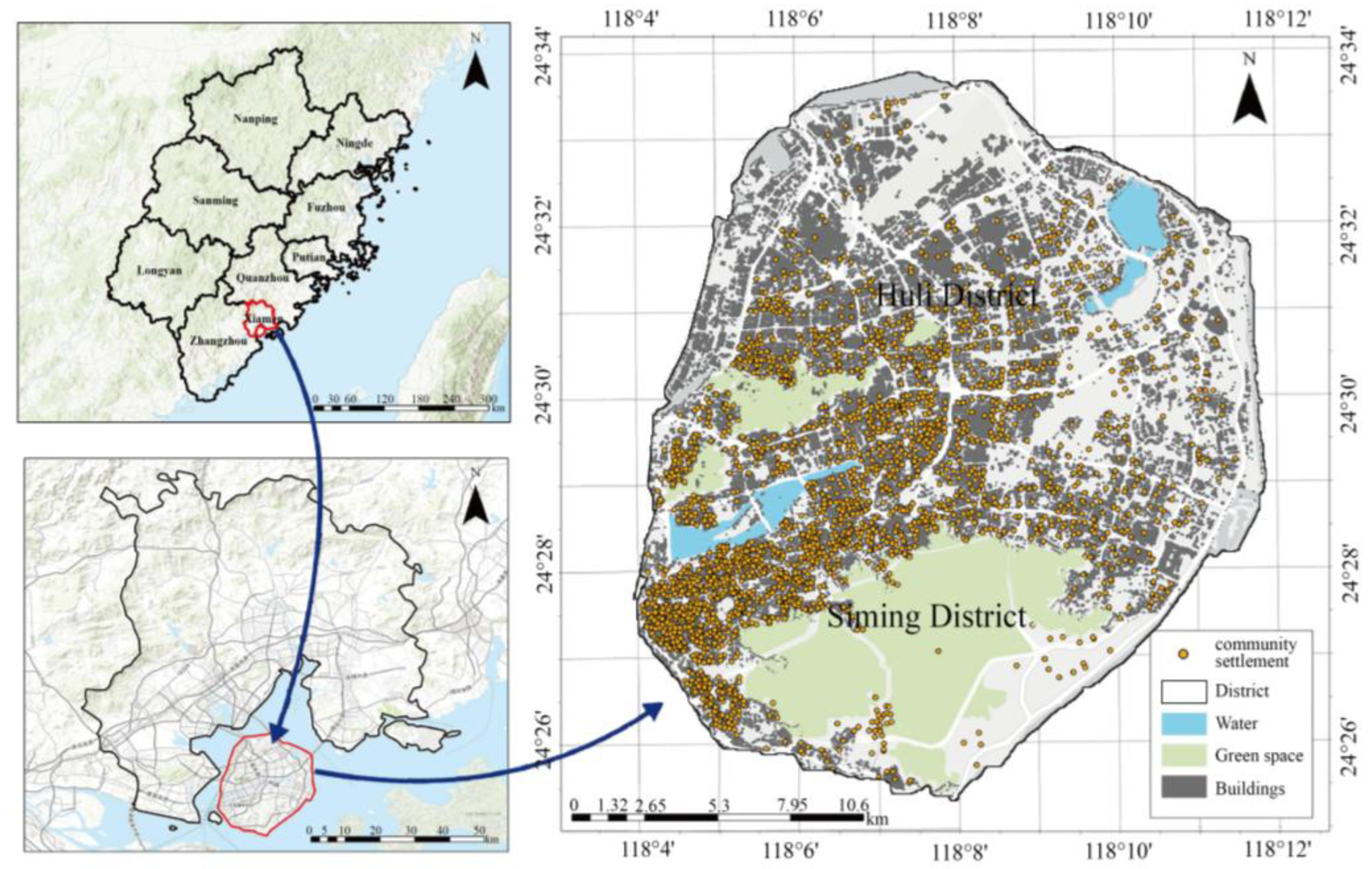

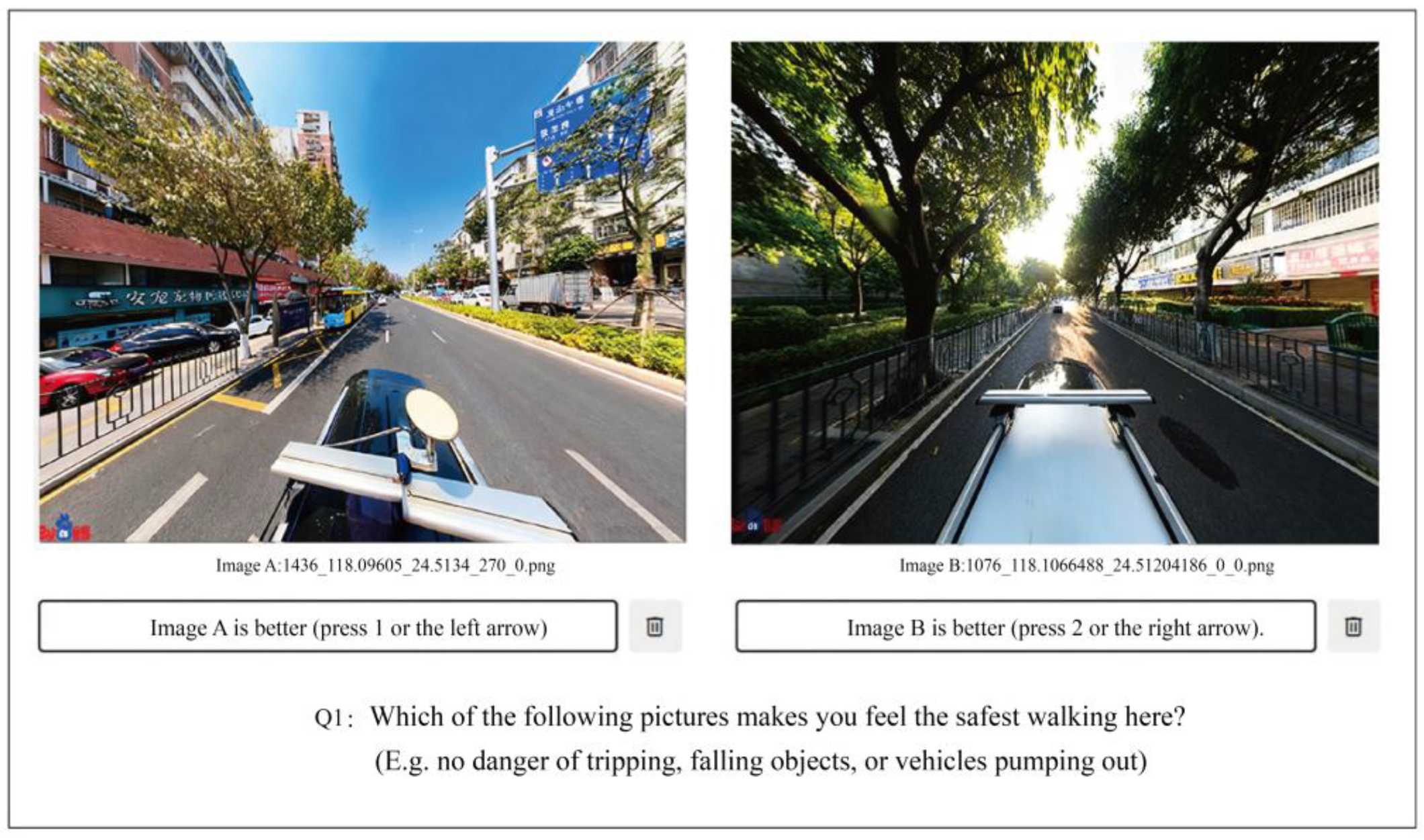
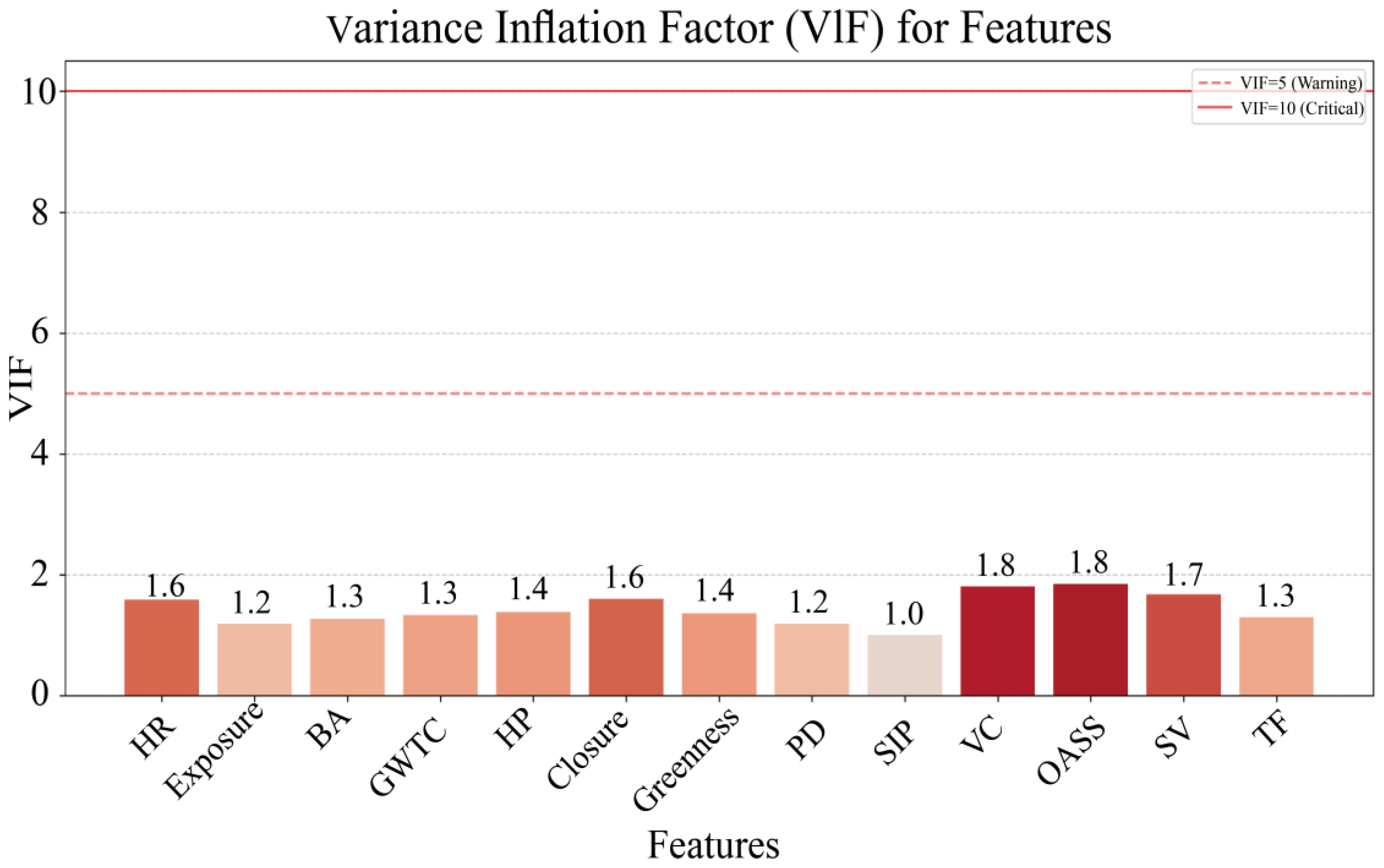



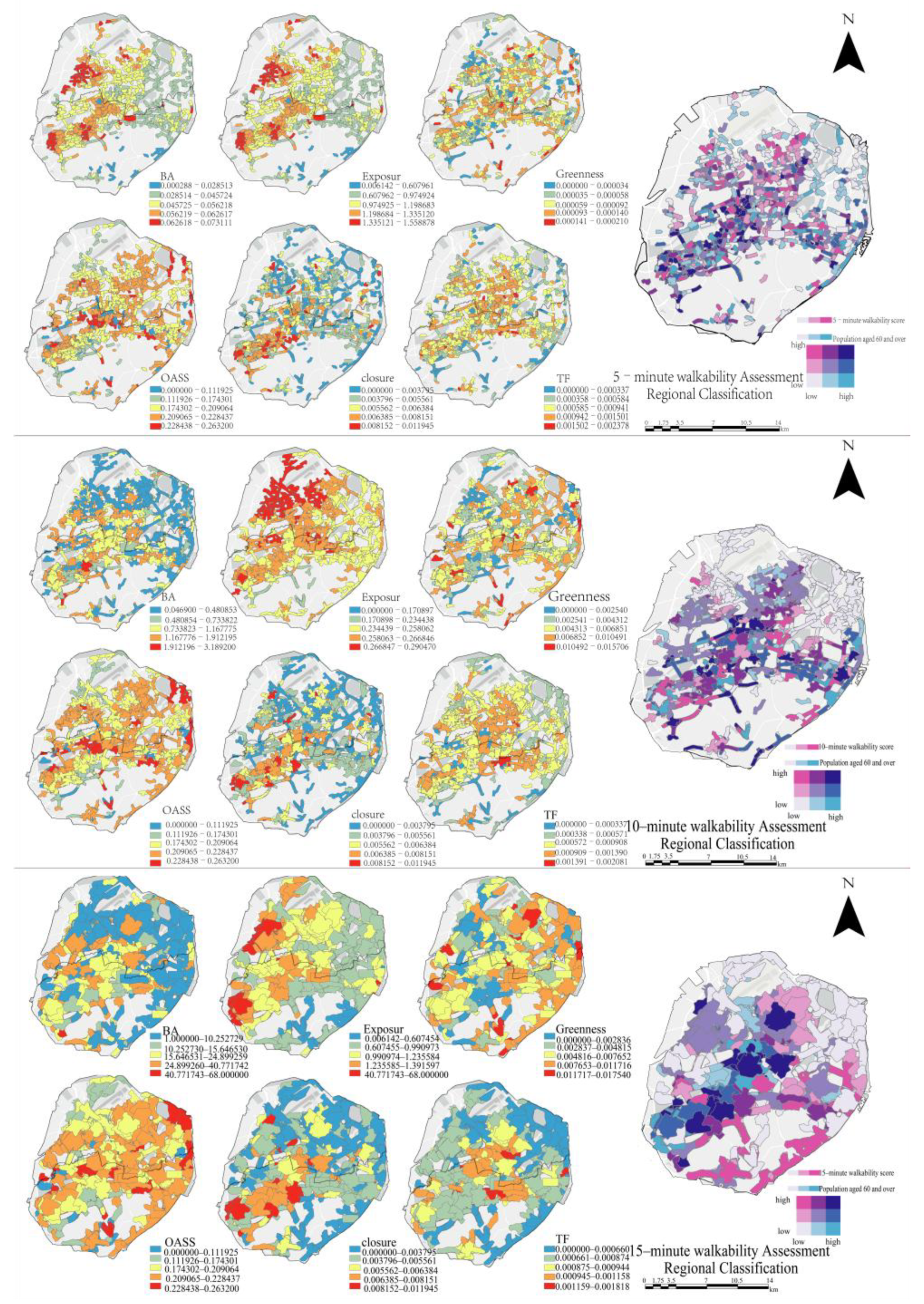


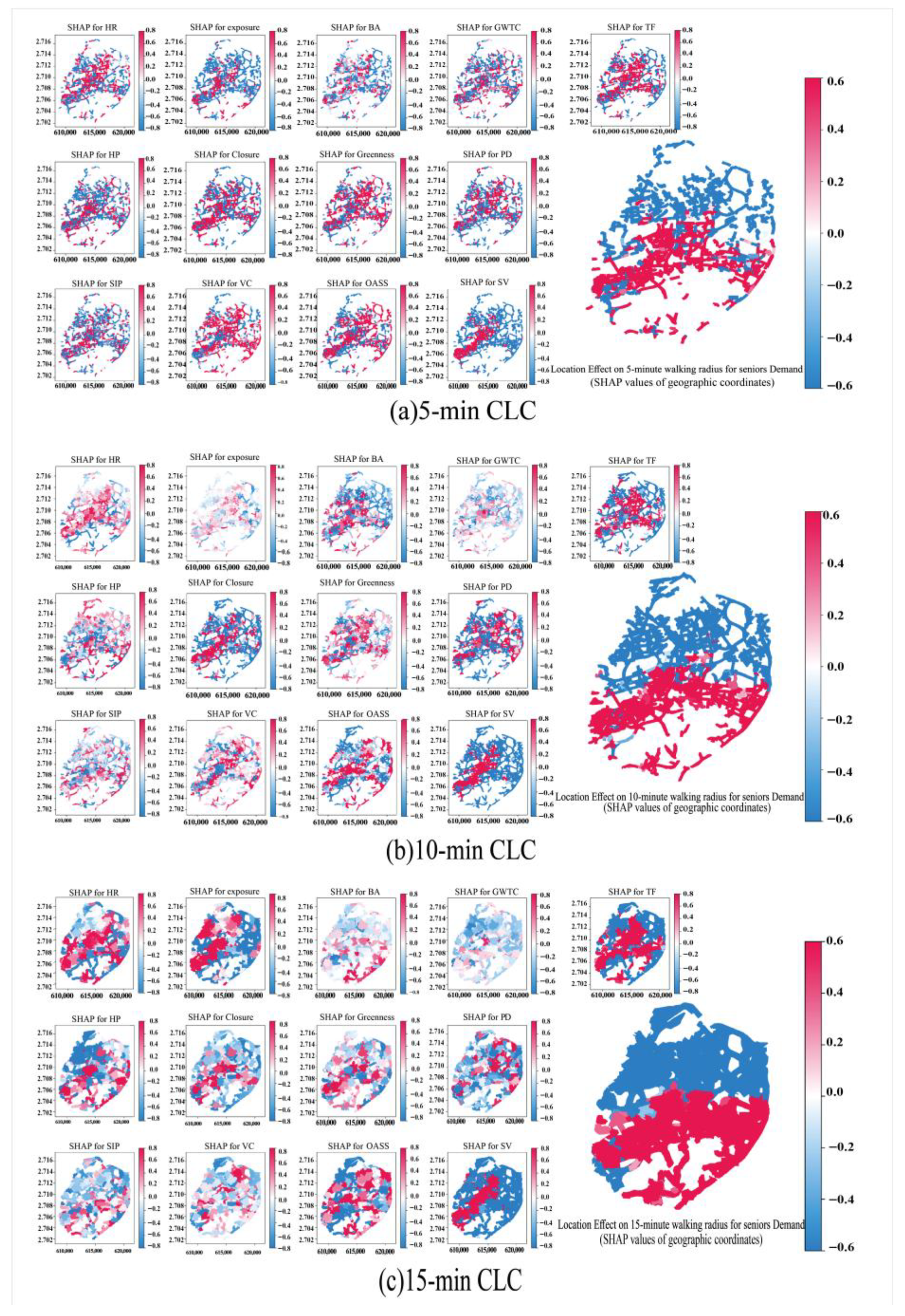

Disclaimer/Publisher’s Note: The statements, opinions and data contained in all publications are solely those of the individual author(s) and contributor(s) and not of MDPI and/or the editor(s). MDPI and/or the editor(s) disclaim responsibility for any injury to people or property resulting from any ideas, methods, instructions or products referred to in the content. |
© 2025 by the authors. Licensee MDPI, Basel, Switzerland. This article is an open access article distributed under the terms and conditions of the Creative Commons Attribution (CC BY) license (https://creativecommons.org/licenses/by/4.0/).
Share and Cite
Su, C.; Chen, Z.; Cheng, Y.; Chen, S.; Li, W.; Ding, Z. Decoding Multi-Scale Environmental Configurations for Older Adults’ Walkability with Explainable Machine Learning. Sustainability 2025, 17, 8499. https://doi.org/10.3390/su17188499
Su C, Chen Z, Cheng Y, Chen S, Li W, Ding Z. Decoding Multi-Scale Environmental Configurations for Older Adults’ Walkability with Explainable Machine Learning. Sustainability. 2025; 17(18):8499. https://doi.org/10.3390/su17188499
Chicago/Turabian StyleSu, Chenxi, Zhengyan Chen, Yuxuan Cheng, Shaofeng Chen, Wenting Li, and Zheng Ding. 2025. "Decoding Multi-Scale Environmental Configurations for Older Adults’ Walkability with Explainable Machine Learning" Sustainability 17, no. 18: 8499. https://doi.org/10.3390/su17188499
APA StyleSu, C., Chen, Z., Cheng, Y., Chen, S., Li, W., & Ding, Z. (2025). Decoding Multi-Scale Environmental Configurations for Older Adults’ Walkability with Explainable Machine Learning. Sustainability, 17(18), 8499. https://doi.org/10.3390/su17188499











